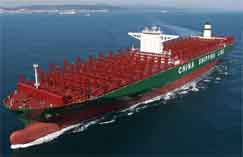Overcapacity and weak demand have played havoc on the financial condition of ocean container carriers in recent years, leading to a wave of outright mergers and acquisitions as well as the formation now of three major alliances in which carriers pool capacity.
The slow growth in container volumes in recent years – barely above global GPD growth, versus two times or more in the 1990 and early 2000s – have led not only to the mergers and alliances in an effort to cut costs, but also to ever larger megaships and much investment in port automation and hugely expensive dredging and other operations to accommodate the larger ships.
Supply Chain Digest Says... |
|
|
While for both the carriers and the ports the individual investments may make sense, often they do not for the industry as a whole, says John Murnane, a consultant at McKinsey on the company's web site.
And service has been effected.
"Port players have taken on a lot of complexity to accommodate changes in the sector," Murnane says. "As a result, port calls are clunkier, customers have different requirements for different sailings of the same service, and the entire process of managing chassis and equipment gets far more complicated."
After interviewing a number of shippers/importers in North America, Murnane says they are largely unhappy and frustrated.
"Many said they would be willing to pay more in return for improvements in, for example, the availability of equipment, reliability, transparency, and communication," Murnane wrote. "Some interviewees went out of their way to tell us that the carriers - not they themselves - had driven down rates" in recent years.
What's more, McKinsey says shippers are increasingly realizing that the service problems are largely the result of conscious decisions made by ocean-freight providers and port operators.
Third, shippers/importers are not all that concerned about transit times. Consistency is the issue, McKinsey says,
"We heard many more requests for reliable delivery dates and better transparency when things go wrong," Murnane writes.
He also provides some interesting comments on Amazon's apparent interest in ocean shipping, after obtaining an ocean-freight-forwarder license in China.
Is Amazon making such moves to cut out middlemen and reduce its costs? Probably not, Murnane says.
"If the company's only goal was to lower the rates it pays for ocean transport or air freight, it could negotiate with the carriers," he says. "In fact, Amazon could probably get just about any rate it wanted in return for a long-term volume commitment."
So what's the game?
Amazon "sees the huge waste of time and money at the intersection of all the different elements - and believes it could eliminate that waste if it had more control over the end-to-end chain," Murnane says.
It's a Fallacy that Shippers will Change Carriers for a Few Bucks
While maybe once shippers would change carriers for a lower price of just $5-10 per container, that is just a fallacy today, Murnane believes.
(See More Below)
|
CATEGORY SPONSOR: SOFTEON |
|
|
| |
|
|
"This used to be true (and in some pockets of the business it still is), but the way customers look at costs is changing," Murnane notes.
 Costs are still very important, but they no longer mean simple things like a carrier's freight rate per container or a terminal's rate per lift, he says. Increasingly, shipper are scrutinizing end-to-end costs to understand the total expense of any supply chain solution. Costs are still very important, but they no longer mean simple things like a carrier's freight rate per container or a terminal's rate per lift, he says. Increasingly, shipper are scrutinizing end-to-end costs to understand the total expense of any supply chain solution.
"Not all shippers can play this game, but it is becoming the norm," Murnane writes.
Two Opportunities
McKinsey sees three major opportunity areas in ocean shipping:
Improving the Customer Experience: To develop a truly differentiated service, liners and portsshould think about two dimensions, Murnane says.
The first relates to ways to increase end-to-end transparency.
"Can you extend into rail? Can you extend into trucks?" Murnane asks carriers.
The second area is in the use of big data and advanced analytics to make predictions and guidance more reliable.
Commercial Excellence: This is a way for carriers to improve their financial fortunes. For example, while shippers increasingly want to look at total end-to-end costs, "most sales calls in the port-and-shipping sector still involve one-on-one interactions: shippers talking to carriers, carriers to terminals, terminals to ports," Murnane says.
McKinsey also says there should be additional expense for peak berthing windows.
"The challenges are significant, but so are the opportunities and potential," Murnane concludes. "Most important, it will require solutions that cross functional lines, company lines, public-versus-private lines, and industry-versus-environment lines."
Most probably agree with that, but presents huge challenges.
Any reaction to McKinsey's take on ocean shipping? Let us know your thoughts at the Feedback section below.
Your Comments/Feedback
|